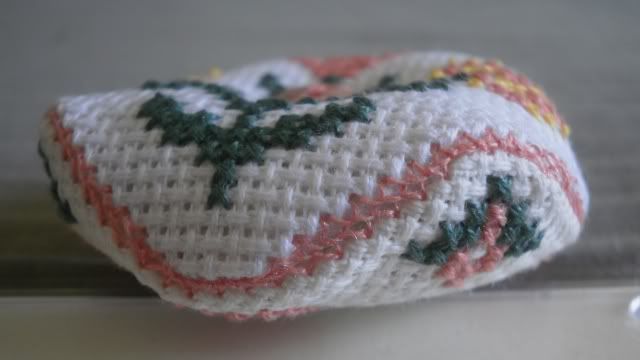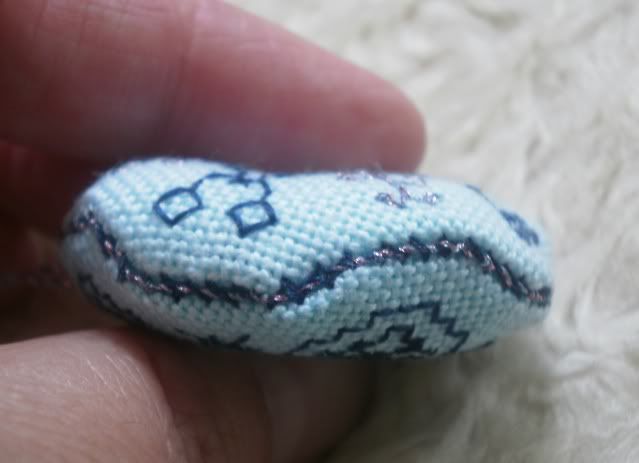Welcome
Welcome to my blog. You can read about my adventures in different types of needlework, and I also offer some free cross stitch patterns. Please, come back often. :)
CAN'T SEE THE PICTURES? READ ABOUT THE PROBLEM HERE.
PLEASE NOTE:
PLEASE, NOTE: The designs on this site are copyrighted to Agnes Palko. They are for your personal use only. They may not be distributed or reproduced without permission.
If you wish to use my patterns to stitch for charity, please, let me know.
31/12/2015
26/12/2015
Christmas stitching 1
Perhaps you could guess from the pictures in my previous post: I was again selling some of my things at the Christmas market. I went to Vattholma julmarknad, this is near where we live, about 20 km from Uppsala, and also to Hågaby - this is in town. They went OK, not too good but better than lat year. I had to realise, again, that you cannot really make profit on needlework. At least I got back the cost of the material.
After the two big markets, I also did small ones in the staff room of my school, and at my boyfriend´s workplace. All the money from those I sent to a charity, and that felt really good.
So here are some of the things I made.
You may remember from the last two years that I love making small embroidered felt ornaments.
I made the usual read and white ones. Forgot to take a good picture of them, and now only have a few left, not the most beautiful ones. They looked like these, but there were different shapes, hearts and stars, decorated with applique, embroidery and beads.
Here is a detail from the above picture on the market, not a really good one but perhaps you can see the variety.
But my favourites were these white ornaments, embroidered with gold metallic thread. Unfortunately they were not as popular a the red-white combination. (Swedish people are quite traditional when it comes to their Christmas decorations.)
This time I also tried making some cross stitched ornaments. It was simply that I missed cross stitch, I didn´t stitch so much lately with all the university assignments. It was fun to stitch them - but did not sell many. I still have a lot of them left.
The ones with the red felt around them were not so easy to make: the felt stretched out of shape a little. Perhaps I should have starched it a bit before cutting.
I also made some felted ball ornaments. They are actually recycling: we make them at school, during the felting unit, and kids often leave them behind if they do not turn out as they expected. So I collected them, worked on them a bit more to make them fully felted, then dyed them in kool-aid. :) Then added some embroidery and beads.
And this year again I made the little walnut-babies. I love them, they have such a great feeling to them, old-fashioned, natural, cute... They speak of Christmas to me.
I wrote about how to make them here. This time I embroidered the star in the middle instead of glueing.
And finally, a few pictures about my embroideries that I made in the summer with flowers and grass. In case you have been wondering how they turned out after 5 months.
They still look quite good. The two flower-pieces haven´t changed at all, the grass has dried but still looks OK. They hang here above my sewing machine, I love looking at them.
Next time I will be coming back with describing my recycling Christmas projects. Watch this place.
Until then, happy stitching.
Agi
After the two big markets, I also did small ones in the staff room of my school, and at my boyfriend´s workplace. All the money from those I sent to a charity, and that felt really good.
So here are some of the things I made.
You may remember from the last two years that I love making small embroidered felt ornaments.
I made the usual read and white ones. Forgot to take a good picture of them, and now only have a few left, not the most beautiful ones. They looked like these, but there were different shapes, hearts and stars, decorated with applique, embroidery and beads.
Here is a detail from the above picture on the market, not a really good one but perhaps you can see the variety.
But my favourites were these white ornaments, embroidered with gold metallic thread. Unfortunately they were not as popular a the red-white combination. (Swedish people are quite traditional when it comes to their Christmas decorations.)
This time I also tried making some cross stitched ornaments. It was simply that I missed cross stitch, I didn´t stitch so much lately with all the university assignments. It was fun to stitch them - but did not sell many. I still have a lot of them left.
The ones with the red felt around them were not so easy to make: the felt stretched out of shape a little. Perhaps I should have starched it a bit before cutting.
I also made some felted ball ornaments. They are actually recycling: we make them at school, during the felting unit, and kids often leave them behind if they do not turn out as they expected. So I collected them, worked on them a bit more to make them fully felted, then dyed them in kool-aid. :) Then added some embroidery and beads.
And this year again I made the little walnut-babies. I love them, they have such a great feeling to them, old-fashioned, natural, cute... They speak of Christmas to me.
I wrote about how to make them here. This time I embroidered the star in the middle instead of glueing.
And finally, a few pictures about my embroideries that I made in the summer with flowers and grass. In case you have been wondering how they turned out after 5 months.
They still look quite good. The two flower-pieces haven´t changed at all, the grass has dried but still looks OK. They hang here above my sewing machine, I love looking at them.
Next time I will be coming back with describing my recycling Christmas projects. Watch this place.
Until then, happy stitching.
Agi
Labels:
broderi,
christmas,
cross stitch,
embroidery,
felt,
filt,
hímzés,
karácsonyi,
keresztszemes,
market,
marknad,
ornament,
vásár,
xstitch
24/12/2015
Merry Christmas. Boldog karácsonyt! God Jul!
I wish all my dear readers a Merry Christmas, relaxing holiday time with lots of good food and needlework. :)
I hope Santa has been listening and will bring you - and me ;) - lots of yarn, thread, fabric, books etc.
Here are a few pictures of what I have been up to lately. Promise to come with some real posts soon - before the New Year. Promise :)
09/08/2015
Another experiment - "temporary embroidery"
I have been playing around with embroidery and nature again. This time I tried to use flowers, leaves and grasses instead of thread in my embroidery. To make things easier, I chose a loosely woven evenwave fabric, and pulled out some threads.
Then I collected some grass and some flowers, just in front of the house. I wove them in in the places where the threads were pulled out, but I found that some of the thiner ones can go in other places too, they could be pulled between the threads of the fabric.
Here is the result.
I am not sure this will look as nice as the previous experiments after a while. The flowers started to bend their heads even as I was working with them.
But I like it so. Part of natures beauty is, I think, that we know it is fleeting, it is there now, but does not stay the same for long. This temporary, or ephemeral embroidery pays homage to this feature of nature.
But even if my embroidery loses its beauty, the photos will keep it forever. I just wish I could take better ones.
Also, embroidering with plants, and preserving them in a photo, could be a nice way of recording the variety of nature in different seasons, or as we travel.
07/08/2015
Embrodery experiments with flowers
Hello, everyone. Hope you are having a lovely summer.
I have actually started working this week. But before that, we went to Hungary and had some lovely time, except that it was so hot, it was too much. I loved coming back to Sweden.
During the holiday I only did a little crafting. I knitted a very simple pullover, I will show it next time.
And I did some embroidery. When I got homework at the university course to do experiments with knitting and sewing, I was a bit nervous, wasn't sure how to experiment, felt a bit insecure. But I actually got to like it. So I decided that I wanted to try something new with embroidery: I tried using real flowers.
I made two pieces: one with a piece of yarrow that, I was hoping, will dry nicely on the fabric - and it does, so far. On the other, I used a few very tiny flowers with colourful petals, and then I pressed them. I thought that the petals may even colour the fabric a bit, but they did not. Still, I like the result a lot. I am curious what will happen to the pressed ones with time.
Here are some pictures:
Hanging on my wall:
On the first one I used feather stitch (without drawing any lines, hence little uneven) and French knots. I took this picture when the yarrow was still fresh:
On the second one it was some lazy daisies and just one straight stitches. Here the flowers were still fresh:
After pressing:
I have one more idea, not saying anything more. I will try at the weekend and we will see how it goes. Watch this place.
Anyone willing to come with me on this journey? It is GREAT FUN!
29/06/2015
Pressed flower - free cross stitch pattern
It is the summer holidays, so what can a girl do but… doing the big cleaning. I was sorting out my books and old notebooks and found some pressed flowers. Or rather some petals. I am sure the flowers were important to me when I pressed them, but I can't remember them. Probably got them from someone precious. I am ashamed that I forgot.
I tried to make a pattern out of them. First I just drew one petal, tried to capture the shading and the gradual change of colours. It is not easy if you are not willing to go huge. Then I put the petals together and made them into a flower. I really wish my program could turn pattern elements in different angles, not only 90°. But as it is, it had to become a four-petal flower.
For once I did not believe the colours my screen showed me (I have made that mistake more often than I care to admit), instead I looked at my threads and put them together in a row. I don´t have the full DMC set, so I had one missing. I hope I managed to find the right colour for that using the DMC colour chart.
I think the pattern is just the right size for a card. My fingers are itching… :)
Let me know what you think.
Click on the picture bellow to get the pdf file.
Happy summer, happy stitching.
Labels:
card,
cross stitch,
free,
freebie,
gratis,
ingyenes,
keresztszemes,
korsstygnsmönster,
minta,
mönster,
pattern,
xstitch
27/06/2015
Blackwork biscornu pattern
I am continuing with the folk art inspired motifs. This time I made a blackwork pattern in blue, for a small biscornu or pincushion.
I am going to Hungary soon, so I probably won´t have time to stitch this, and anyway, I am full of half-finished projects, so I should not start something new. But knowing myself, I can´t promise anything :)
Hope you like this little pattern. Let us see if you make it!
Happy stitching
08/06/2015
Biscornu and bookmark inspired by folk patterns
I was reading a book about the folk art of Kászon - now in Romania, originally a Hungarian area. I was, of course, inspired by the many beautiful pictures and patterns.
The following biscornu and bookmark are using elements that are traditional in Kászon, but are also present in many other areas. However, I tried to create a new design using the old motifs, added my own interpretation.
The biscornu can also be made as a mattress pincushion, so I added a piece for the sides.
I hope you like and stitch them.
Labels:
biscornu,
bokmärke,
bookmark,
cross stitch,
folk art,
free,
freebie,
gratis,
Hungarian,
ingyenes,
keresztszemes,
könyvjelző,
korsstygnsmönster,
magyar,
minta,
népi,
pattern,
pincushion,
xstitch
02/06/2015
More about biscornu - my own ideas
As promised, here come some more ideas and experiments with the biscornu and its variations, as well as some other types of pincushions.
1. Cross stitch (or any embroidery) on one side, backing fabric on the other.
The big biscornu I showed you last time, was made from a cross stitched square and a piece of fabric on the backside (unfortunately it does not show in the picture, and since it was a gift to someone, I cannot take more photos). I did not do the backstitched border and the whipstitching on this, I simply sewed the two squares right sides together, one corner matched to the centre of the other square. I sewed by hand, as I did not have a sewing machine back then.
I was wondering if it was possible to do it "properly", I mean with backstitch and whipstitch, even when you have another type of fabric on one side. The key would be to make backstitches on the other fabric the same size as on the Aida, then it should work. Need to try one day. Has anyone done this?
2. Biscornu made of felt, with blanket stitch.
I often do embroidery on a piece of felt when I sit in the classroom with my year 5 classes. When they have started their sewing and they don´t need my help so often, I sit down at the table with them and doodle with a piece of felt and some leftover thread pieces. They like to see that I sew for my own pleasure and often get inspired by what I do. This little embroidered piece was the product of such lessons. I then put it together with another square the same size and sewed them together with blanket stitch. It turned out OK, although it was much more difficult to match the corners than with Aida. It is not easy to be exact with the blanket stitch, and the felt stretched out a little as I was sewing. Some corners are not perfect, but all in all, I like the result.
I think it probably works with any other fabric plus blanket stitch - felt is just easier because it does not fray.
3. Biscornu with no sharp corners
Another variation that I came up with is what I call "the wavy biscornu". I designed the pattern so that I cut off the corners of the squares, and the biscurnu becomes softer in appearance, the corners are not so pronounced. I really like the effect.
Here and here you can see how the pattern looks like for such a biscornu. I marked with arrows on the pattern how the squares should be put together.
4. A cube pincushion
Here is another shape I came up with: it looks like a cross shaped pattern when embroidered, but then it comes together to a little cube. For a long time this was my most popular pattern on the blog. :)

5. Then, of course, there is the more traditional pillow-shaped pincushion, that can also be done with a button in the middle:
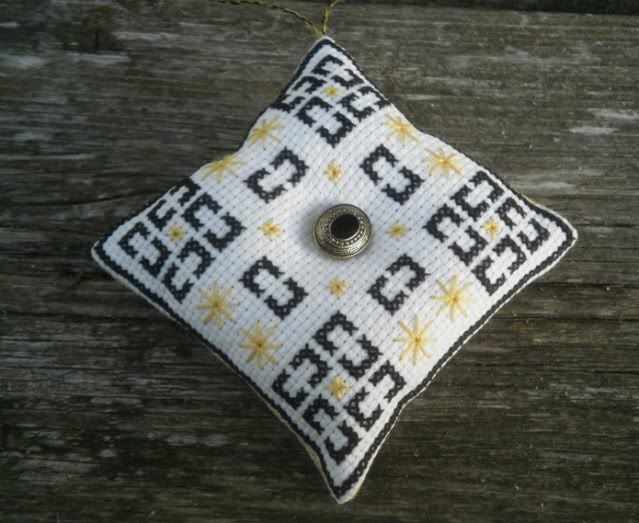
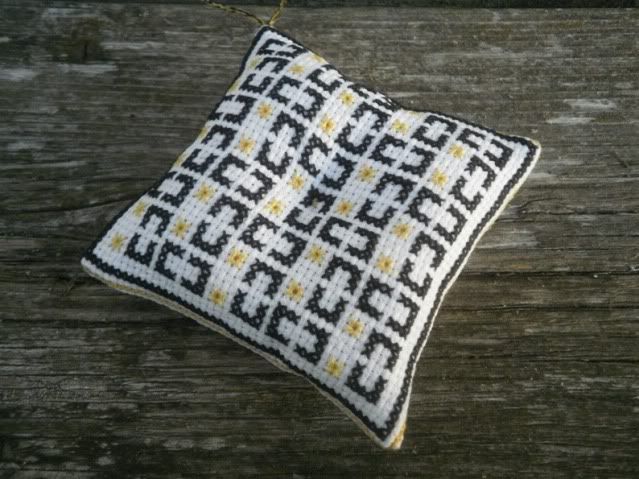
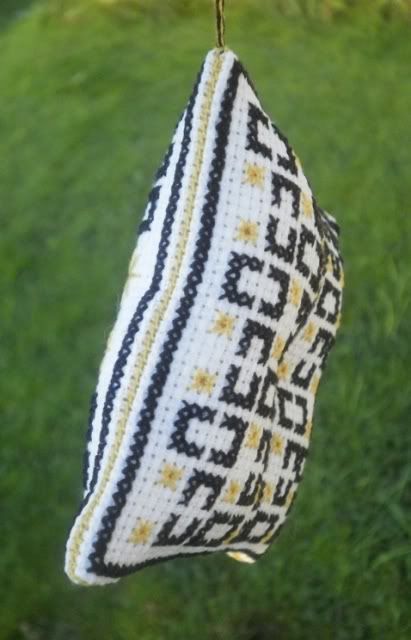
6. A variation on this is the so called mattress pin cushion, when you sew a narrow rectangle on all the four sides between the two squares. This is what I did with my latest pattern:
If you need detailed instructions for this type of pincushion, you can find one on this blog.
If you find a biscornu (or any square) pattern that you like, it is easy to turn it into a mattress pincushion. Design the small rectangles yourself: they should be the same width as the squares, and only 10-12 stitches high. Then find a small element in the original pattern that you can put in these rectangles.
7. Bi-biscornu
I have also come up with another shape that I called the "bi-biscornu". It is a cross between a biscornu and a mattress pincushion.
I have promised to write how it is made but never did, so perhaps it is time to do it.
Here is the pattern. It was made before I got my cross stitch program, it is not a pdf file, just a picture. Right click to download.
As you see, the pattern has exactly the same pieces as for the mattress pincushion. To sew together, match a corner of a small rectangle to the middle of a square. Start whipstitching together. Then add the next rectangle and the next. Then sew the other square the same way: the middle of the square meets the corners of the rectangles. I hope it makes sense.
8. And finally, some unusual shapes I have experimented with, that also use the backstitched line + whipstitching method.



These are patterns for sale, you can find them here.
I hope you can find inspiration for pincushions and biscornus in these posts. Please, send a picture if you make one of these, I would be happy to post them on the blog.
Happy stitching!
1. Cross stitch (or any embroidery) on one side, backing fabric on the other.
The big biscornu I showed you last time, was made from a cross stitched square and a piece of fabric on the backside (unfortunately it does not show in the picture, and since it was a gift to someone, I cannot take more photos). I did not do the backstitched border and the whipstitching on this, I simply sewed the two squares right sides together, one corner matched to the centre of the other square. I sewed by hand, as I did not have a sewing machine back then.
I was wondering if it was possible to do it "properly", I mean with backstitch and whipstitch, even when you have another type of fabric on one side. The key would be to make backstitches on the other fabric the same size as on the Aida, then it should work. Need to try one day. Has anyone done this?
2. Biscornu made of felt, with blanket stitch.
I often do embroidery on a piece of felt when I sit in the classroom with my year 5 classes. When they have started their sewing and they don´t need my help so often, I sit down at the table with them and doodle with a piece of felt and some leftover thread pieces. They like to see that I sew for my own pleasure and often get inspired by what I do. This little embroidered piece was the product of such lessons. I then put it together with another square the same size and sewed them together with blanket stitch. It turned out OK, although it was much more difficult to match the corners than with Aida. It is not easy to be exact with the blanket stitch, and the felt stretched out a little as I was sewing. Some corners are not perfect, but all in all, I like the result.
I think it probably works with any other fabric plus blanket stitch - felt is just easier because it does not fray.
3. Biscornu with no sharp corners
Another variation that I came up with is what I call "the wavy biscornu". I designed the pattern so that I cut off the corners of the squares, and the biscurnu becomes softer in appearance, the corners are not so pronounced. I really like the effect.
Here and here you can see how the pattern looks like for such a biscornu. I marked with arrows on the pattern how the squares should be put together.
4. A cube pincushion
Here is another shape I came up with: it looks like a cross shaped pattern when embroidered, but then it comes together to a little cube. For a long time this was my most popular pattern on the blog. :)

5. Then, of course, there is the more traditional pillow-shaped pincushion, that can also be done with a button in the middle:



6. A variation on this is the so called mattress pin cushion, when you sew a narrow rectangle on all the four sides between the two squares. This is what I did with my latest pattern:
If you need detailed instructions for this type of pincushion, you can find one on this blog.
If you find a biscornu (or any square) pattern that you like, it is easy to turn it into a mattress pincushion. Design the small rectangles yourself: they should be the same width as the squares, and only 10-12 stitches high. Then find a small element in the original pattern that you can put in these rectangles.
7. Bi-biscornu
I have also come up with another shape that I called the "bi-biscornu". It is a cross between a biscornu and a mattress pincushion.
I have promised to write how it is made but never did, so perhaps it is time to do it.
Here is the pattern. It was made before I got my cross stitch program, it is not a pdf file, just a picture. Right click to download.
As you see, the pattern has exactly the same pieces as for the mattress pincushion. To sew together, match a corner of a small rectangle to the middle of a square. Start whipstitching together. Then add the next rectangle and the next. Then sew the other square the same way: the middle of the square meets the corners of the rectangles. I hope it makes sense.
8. And finally, some unusual shapes I have experimented with, that also use the backstitched line + whipstitching method.



These are patterns for sale, you can find them here.
I hope you can find inspiration for pincushions and biscornus in these posts. Please, send a picture if you make one of these, I would be happy to post them on the blog.
Happy stitching!
Labels:
biscornu,
cross stitch,
free,
freebie,
gratis,
ingyenes,
keresztszemes,
korsstygnsmönster,
minta,
mönster,
motif,
pattern,
pincushion,
xstitch
Subscribe to:
Posts (Atom)





















































